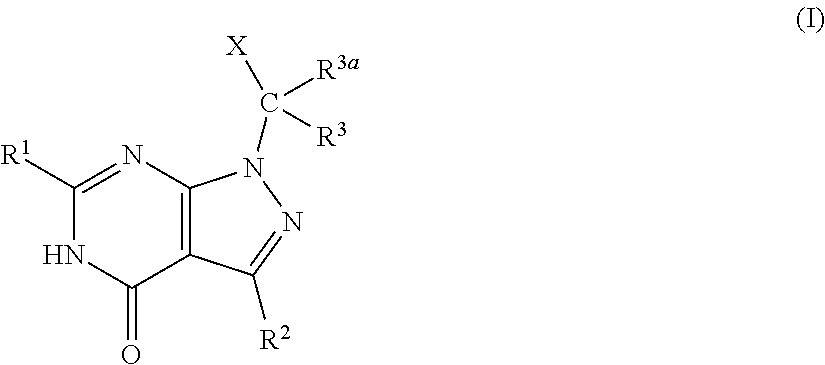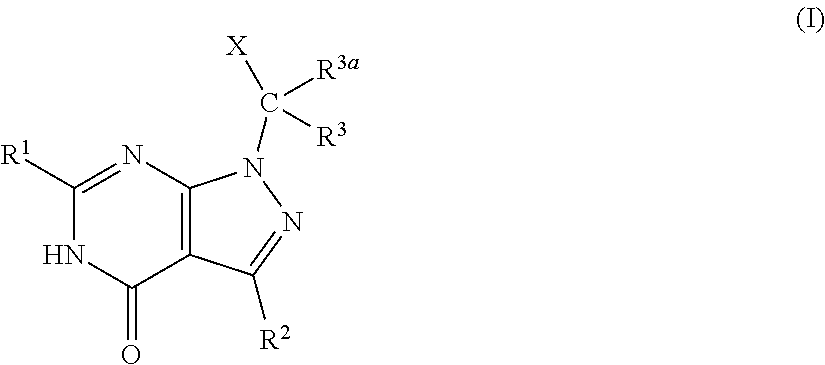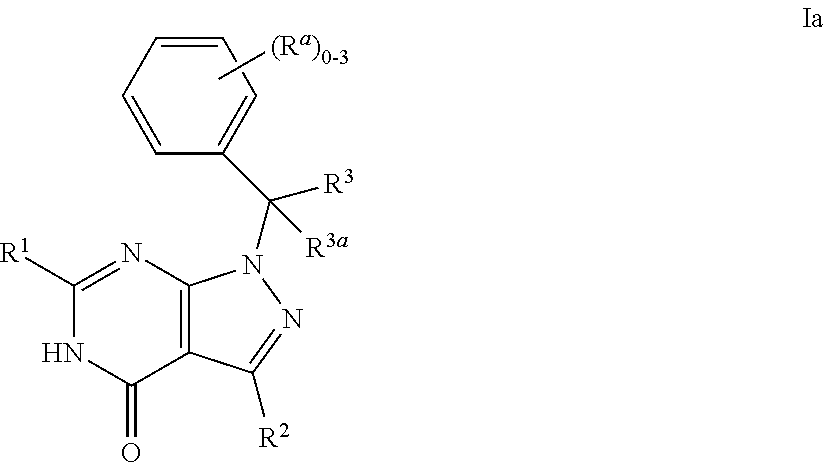6-alkyl dihydropyrazolopyrimidinone compounds as PDE2 inhibitors
a technology of pyrimidinone and dihydropyrazolopyrimidinone, which is applied in the direction of drug compositions, organic chemistry, nervous disorders, etc., can solve the problems of high non-compliance or discontinuation rate of medication, lack of efficacy, and high rate of non-compliance or discontinuation of medication
- Summary
- Abstract
- Description
- Claims
- Application Information
AI Technical Summary
Benefits of technology
Problems solved by technology
Method used
Image
Examples
preparatory example 1
[0319]
1-(6-(Trifluoromethyl)pyridazin-3-yl)ethanone (Scheme 1)
Step 1. 3-(1-Ethoxyvinyl)-6-(trifluoromethyl)pyridazine
[0320]To a solution of 3-chloro-6-(trifluoromethyl)pyridazine (0.30 g, 1.6 mmol) in toluene (3 mL) were added tributyl(1-ethoxyvinyl)stannane (1.2 g, 3.3 mmol) and Pd(PPh3)4 (1.90 g, 1.64 mmol) at RT. The mixture was purged with nitrogen for 3 times and stirred at 120° C. for 16 h under nitrogen. The mixture was cooled to RT and filtered. The filter cake was washed with ethyl acetate (20 mL) and the resultant filtrate was diluted with sat. aq. KF solution (30 mL). The layers were separated and the aqueous layer was extracted with ethyl acetate (3×10 mL). The organic layers were combined, dried over Na2SO4, filtered, and concentrated under reduced pressure. The residue was purified by silica gel column chromatography (5% ethyl acetate in petroleum ether) to afford the title compound as an oil. MS=219.0 (+ESI).
Step 2. 1-(6-(Trifluoromethyl)pyridazin-3-yl)ethanone
[0321]T...
preparatory example 7
[0323]
1-(3-Methyl-4-(trifluoromethyl)phenyl)ethanone (Scheme 2)
Step 1. 4-(1-Butoxyvinyl)-2-methyl-1-(trifluoromethyl)benzene
[0324]Diacetoxypalladium (3.7 mg, 0.02 mmol), 1,3-bis(diphenylphosphino)propane (14 mg, 0.03 mmol), 1-(vinyloxy)butane (0.67 g, 6.7 mmol) and triethylamine (0.70 mL, 5.0 mmol) were added to a solution of 4-bromo-2-methyl-1-(trifluoromethyl)benzene (0.40 g, 1.7 mmol) in ethylene glycol (2 mL) at RT. The mixture was purged with nitrogen 3 times and stirred at 145° C. for 3 h under nitrogen. The mixture was cooled to RT, diluted with brine (50 mL), and the mixture was extracted with CH2Cl2 (3×50 mL). The organic layers were combined, dried over Na2SO4, filtered, and concentrated under reduced pressure to afford the title compound as a liquid. The title compound was used directly in the next step without purification. MS=259.0 (+ESI).
Step 2. 1-(3-Methyl-4-(trifluoromethyl)phenyl)ethanone
[0325]To a solution of 4-(1-butoxyvinyl)-2-methyl-1-(trifluoromethyl)benzene (0...
preparatory example 10
[0327]
1-(5-(Trifluoromethyl)thiophen-2-yl)ethanone (Scheme 3)
[0328]To a stirred solution of 1-(5-bromothiophen-2-yl)ethanone (2.00 g, 9.8 mmol) in N-methyl-2-pyrrolidinone (8 mL) were added copper(I) iodide (0.46 g, 2.4 mmol) and methyl 2,2-difluoro-2-(fluorosulfonyl)acetate (5.62 g, 29.3 mmol) at RT. The reaction mixture was purged with nitrogen for 3 times and stirred under nitrogen atmosphere at 135° C. for 16 h. The resulting mixture was cooled to RT, diluted with water (100 mL) and extracted with ethyl acetate (3×30 mL). The organic layers were combined, washed with brine (1×60 mL), and dried over Na2SO4. The organic layer filtered and concentrated under reduced pressure. The residue was purified by silica gel column chromatography (0-20% ethyl acetate in petroleum ether) to afford the title compound as an oil. MS=194.8 (+ESI)
PUM
| Property | Measurement | Unit |
|---|---|---|
| flow rate | aaaaa | aaaaa |
| flow rate | aaaaa | aaaaa |
| flow rate | aaaaa | aaaaa |
Abstract
Description
Claims
Application Information
 Login to View More
Login to View More - R&D
- Intellectual Property
- Life Sciences
- Materials
- Tech Scout
- Unparalleled Data Quality
- Higher Quality Content
- 60% Fewer Hallucinations
Browse by: Latest US Patents, China's latest patents, Technical Efficacy Thesaurus, Application Domain, Technology Topic, Popular Technical Reports.
© 2025 PatSnap. All rights reserved.Legal|Privacy policy|Modern Slavery Act Transparency Statement|Sitemap|About US| Contact US: help@patsnap.com



